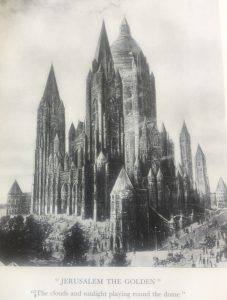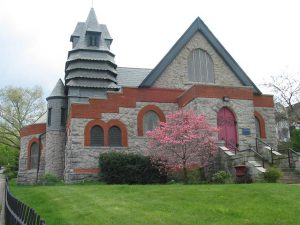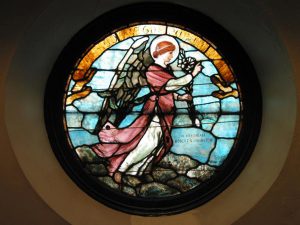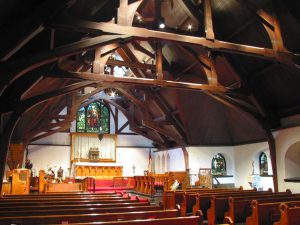
Architecture Feature: William Halsey Wood in Pittsburgh
“Completely original and unprecedented”: William Halsey Wood in Pittsburgh and Southwestern Pennsylvania
By Albert Tannler
 In 1937, Ralph Adams Cram, then this country’s leading church architect, wrote the preface to a book about a New Jersey architect who had been dead for 40 years and whom he had never met. This architect had been, Cram wrote, “a man of genius whose name, after so many years, has been forgotten by all but a few of my own generation and profession.” [1]
In 1937, Ralph Adams Cram, then this country’s leading church architect, wrote the preface to a book about a New Jersey architect who had been dead for 40 years and whom he had never met. This architect had been, Cram wrote, “a man of genius whose name, after so many years, has been forgotten by all but a few of my own generation and profession.” [1]
The architect was William Halsey Wood (1855-1897), perhaps best known for his 1888 competition design for the Cathedral of St. John the Divine in New York City. Wood’s design, “Jerusalem the Golden,” was one of four finalists. Although the commission went to another firm, Wood’s design was displayed at the Chicago World’s Fair in 1893 and won a gold medal.
“Halsey Wood’s design,” Cram wrote, “was neither Richardsonian nor Victorian Gothic, nor indeed quite like anything else ever recorded in history; it was an artistic tour de force, completely original and unprecedented.”[2] Had Wood’s design been chosen:
it might very possibly have considerably modified the course of development in American architecture. In a sense he anticipated [Louis] Sullivan, [Frank Lloyd] Wright, [Bertram] Goodhue and the other path-breakers towards modernism …. Halsey Wood indicated the possibility of a rather convincing amalgamation of historic tradition and a revivifying modernism, and he very well might have become the leader of a new school of design.[3]
Wood was, Cram concludes, “a great and creative artist, measurably in accomplishment, but greater still in potentiality.”[4]
Wood’s designs for Southwestern Pennsylvania included:
- the Carnegie Library of Braddock (1888-89), which was the first library building in the United States to be funded by Andrew Carnegie;
- a design for the Carnegie Library of Pittsburgh,
 illustrated in the American Architect & Building News, May 21, 1892, but not realized;
illustrated in the American Architect & Building News, May 21, 1892, but not realized; - the Church of the Good Shepherd in Hazelwood (1891-92), characterized as “rather fantastic”[5] by the region’s leading architectural historian, James D. Van Trump;
- St. Peter’s Episcopal Church, Butler, Pa. 1895-96)[6]; and
- the Church of the Ascension (1896-98) in Pittsburgh. [7] Wood was given the commission and completed the design, but he died of tuberculosis on March 13, 1897 at the age of 41. The architectural drawings were received from his estate and the building was erected by Alden & Harlow, whose predecessor firm, Longfellow, Alden & Harlow, had added the music hall to Wood’s Braddock Library in 1893. Wood’s design draws upon Late English Gothic forms. The interior is yellow Kittanning brick (now painted) with a great wooden ceiling and arresting saw-tooth chancel arch; the rough stone exterior is dominated by a Tudor tower modeled after one of 1506 in Wrexham, Wales. Van Trump, in his 75th Anniversary article on Ascension, states:
It is the rugged, masculine mass of the building, the rock-like texture of its walls and the paucity of ornament which give an especially ‘Pittsburgh’ tone and feeling to the structure. Wood, like Richardson before him in the design of the great Allegheny County Court House and Jail, succeeded almost spectacularly in interpreting the spirit of the Steel City.[8]
The church furnishings were designed by J. & R. Lamb Studios of New York City; eighteen stained glass windows were designed and made by Healy & Millet of Chicago
––George Healy and Louis Millet had attended the Ecole des Beaux-Arts in Paris with Louis Sullivan and these artists frequently worked together; and in 1918-19, redecoration of the small chapel on the south side of the chancel began, supported by the Gordon family. Ralph Adams Cram designed the Chapel and the six small antique glass windows are the work of Charles J. Connick of Boston, Cram’s preferred glazer (who grew up in Pittsburgh and apprenticed in glass studios here).
Although Connick’s glass in the Gordon Chapel consists of simple gray and blue “grisaille” panels, colorful saints eventually filled the clerestory windows that Healy & Millet left empty. The antique glass windows were designed and made by Howard Wilbert of Pittsburgh Stained Glass Studios (1918) and George Hunt of Hunt Studios (1962-64) and are ambitious local examples of Modern Gothic glassmaking. The installation of the last of these windows in 1964 concluded the dialogue between architects, designers, and craftsmen begun in 1896.
One of the most interesting and satisfactory ecclesiastical buildings that Wood designed and completed during his lifetime is the Church of the Good Shepherd (1891-92) in Hazelwood. Van Trump observed in 1967:
This asymmetrical and rather fantastic structure with its frilled shingle tower recalls very pleasantly the rugged, stylish “natural” contours of those late nineteenth century suburban churches boldly designed by a small number of “original” architects, a group that might be described as the “boulder and shingle” school. . . . The church should be preserved as a unique local representative of its type.[9]
In 1997 Walter Kidney wrote:
Good Shepherd has an artfully rustic expression. An industrial town has grown around it, yet with its low walls of rubble and dark-red brick, its prominent roof, its much louvered, shingled little tower it announces itself as a simple country church. Such a quality of sophisticated humility, a practice of rejecting pompous gestures and ornamental displays in favor of plain materials and vernacular forms––yet composing these with a very knowing eye––had begun early in the Romantic period and would persist far into the twentieth century.[10]
The stained glass windows were designed and made by Ludwig Grosse (1862-1917), born and educated in Munich, Germany. Grosse arrived in Pittsburgh in 1888. In 1889 he began to work in stained glass; in 1890 he was working for the Pittsburgh glass firm of S.. S. Marshall & Brothers, purchased their downtown studio and opened the L. Grosse Art Glass Company, which continued under his name through 1898. In 1899 and 1900 he is listed as a dealer in “art works.” Grosse appears to have left Pittsburgh thereafter.
 In 1897, Gross hired William Willet of Philadelphia, who moved to Pittsburgh and became art director of the L. Grosse Art Glass Company; in 1899 Willet established his own firm, Willet Stained Glass & Decorating Company, in Pittsburgh.[11]
In 1897, Gross hired William Willet of Philadelphia, who moved to Pittsburgh and became art director of the L. Grosse Art Glass Company; in 1899 Willet established his own firm, Willet Stained Glass & Decorating Company, in Pittsburgh.[11]
Gross’s work at The Church of the Good Shepherd was described in The Bulletin (October 29, 1892):
The dedicatory services of the Protestant Episcopal Church of the Good Shepherd, Hazelwood . . . will take place tomorrow morning . . . . The inside is beautifully frescoed and the windows, made from designs by Mr. Ludwig Grosse, of this city, are both handsome and artistic.[12]
Illustrations:
- “Jerusalem the Golden”
- Church of the Good Shepherd – exterior
- Church of the Good Shepherd – interior
- Robert S. Johnston Memorial window, designed by Ludwig Grosse.
[1] Ralph Adams Cram, “Preface.” Memories of William Halsey Wood By His Wife (Privately printed 1937), 9.
[2] Ibid., 10.
[3] Ibid., 11
[4] Ibid., 13.
[5] James D. Van Trump, “Church of the Good Shepherd,” Landmark Architecture of Allegheny County Pennsylvania (Pittsburgh History & Landmarks Foundation, 1967), 121.
[6] Butler is 29 miles north of Pittsburgh; the first service at this church was held January 17, 1897.
[7] The primary sources for information about the Church of the Ascension are James D. Van Trump, “Pittsburgh’s Church of the Ascension,” The Charette 36:6 (June 1956), 14-16, 29, reprinted in Life and Architecture in Pittsburgh (Pittsburgh History & Landmarks, 1983), 171-176, and Van Trump, “The Church of the Ascension, Pittsburgh: A Brief Chronicle of Its Seventy-Five Years,” Western Pennsylvania Historical Magazine 48:1 (January 1965): [1-18], 15; 17. Van Trump’s research notes are preserved in the James D. Van Trump Library, Pittsburgh History & Landmarks Foundation. See also Marilyn P. Whitmore, Centennial History: Church of the Ascension 1889-1989. Pittsburgh: Privately printed, 1989.
[8] Van Trump, “A Brief Chronicle,” 10.
[9] Van Trump, Landmark Architecture of Allegheny County, Pennsylvania (PHLF 1967): 121.
[10] Kidney, Pittsburgh’s Landmark Architecture: The Historic Buildings of Pittsburgh and Allegheny County (PHLF 1997): 459.
[11] See Albert M. Tannler, William Willet in Pittsburgh 1897-1913: A Research Compendium (PHLF 2005).
[12] See also “Ludwig Grosse Art Glass Company,” History and Commerce of Pittsburgh and Environs: Consisting of Allegheny, McKeesport, Braddock and Homestead 1893-1894 (New York: A. F. Parsons Publishing Co., 1893): 83.
